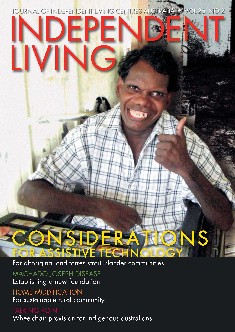
Publications
Independent LivingVolume 25 No 2
published in July 2009
Featured Articles
Considerations for AT in ATSI communities
Living in remote outback Australia immediately presents difficulties for some in accessing a broad range of assistive technology (AT) and servicing/maintaining current assistive technology. Distance, lack of access to suppliers, lack of transport options, reduced access to health professionals and other services highlight the areas of restriction that impede provision of appropriate AT.Aboriginal and Torres Strait Islander people with disability are presented with these challenges in a quest to locate suitable assistive technology.
Machado Joseph Disease - Setup New Foundation
Far, far away there is a tiny town on a tiny island in the Gulf of Carpentaria. The Island is called Bickteron Island and the town is 'Milyakburra'. To get there from Darwin, you must first fly the 1.5 hour flight to Groote Eylandt, and then take a charter flight on a single engine Cessna another 20 minutes over cerulean blue waters to Bickerton Island. It's a beautiful island, part of the Groote Eylandt archipelago in remote north eastern Arnhem Land. This is the traditional 'country' of the Warnindilyakwa people. They are Ancient and beautiful places,....but they harbour a tragic secret story. It is a secret of 'shame' and 'blame'....it is the story of the struggle of this proud and ancient people with an old and deadly foe, a fatal inherited disease called Machado Joseph Disease.Machado Joseph Disease is a cruel and complex disease, robbing those who have it of their independence and dignity. It occurs in families, often starting in late adulthood with each child of an affected person at a 50% risk of developing the disease themselves, almost always at an earlier age than their parent. It is an old disease, some strains are thought to be up to 4000 years old, and its worldwide spread has been attributed to the trading activites of Portuguese and Chinese sailors. Although rare in mainstream Australia, the incidence of MJD in these communities is the highest in Australia. In some of the Groote and Bickerton families carers struggle to support three generations concurrently. It is a terrible story, but it is not unique to Groote. The disease also affects several other Indigenous Arnhem land and Central Australian communities, occurs in small numbers in other regions and is known on every continent on earth.
What is unique to this remote and isolated region are some formidable barriers to providing high needs support, conducting appropriate research and providing quality care. Isolation and distance, and the attendant costs, combined with complex kinship and language systems and a transient professional population have meant that access to equipment, services and facilities found elsewhere requires significant and co-ordinated resources over many years. The MJD Foundation was established in May 2008 to meet these needs.
Home Modification for Sustainable Rural Community
Home modifications are in the spotlight within health care practice because of its important role in injury prevention, particularly amongst older people. Despite the known benefits, home modification services within the rural health care system are not always as available as in urban communities. Rural home modification in Australia has been largely neglected as an important area for research. So the Home Modification Information Clearinghouse (HMinfo) team sought to build a more complete picture of rural home modification in Australia by anlysing all available datasets including the Home and Community Care Minimum Dataset unit record files (HACC MDS) previously made available by the Commonwealth for the years 2001-2006.It is claimed that the health care needs of rural residents have never been successfully met (Smith, Humphreys, & Wilson, 2008). While the proportion of the population aged 65 years plus living in non-metropolitan areas is smaller, they have greater health care needs and these unmet health needs are increasing (Hugo, 2002). Historically, a lack of funding and staff has led to limited health services in rural areas, so innovative solutions for sustainable rural health care need to encompass more active collaborations from rural participants (Larson, 2002).
Wheelchair provision for Indigenous Australians
Motivation Australia is a not for profit NGO that works to enhance the quality of life of people with mobility disabilities in the Asia Pacific region. Motivation Australia has grown out of the UK based organisation Motivation, founded in 1991. In over 30 low income countries, Motivation has worked closely with local organisations as well as wheelchair users to implement sustainable programmes to improve wheelchair provision.Motivationís work includes appropriate wheelchair design and production, capacity building to increase effective service delivery and training of local clinical and technical staff in wheelchair provision. Motivation programmes emphasise affordability, appropriateness, user choice and participation. Our partnerships ensure that local people and organisations have the skills to meet the needs of disabled people in their communities.
